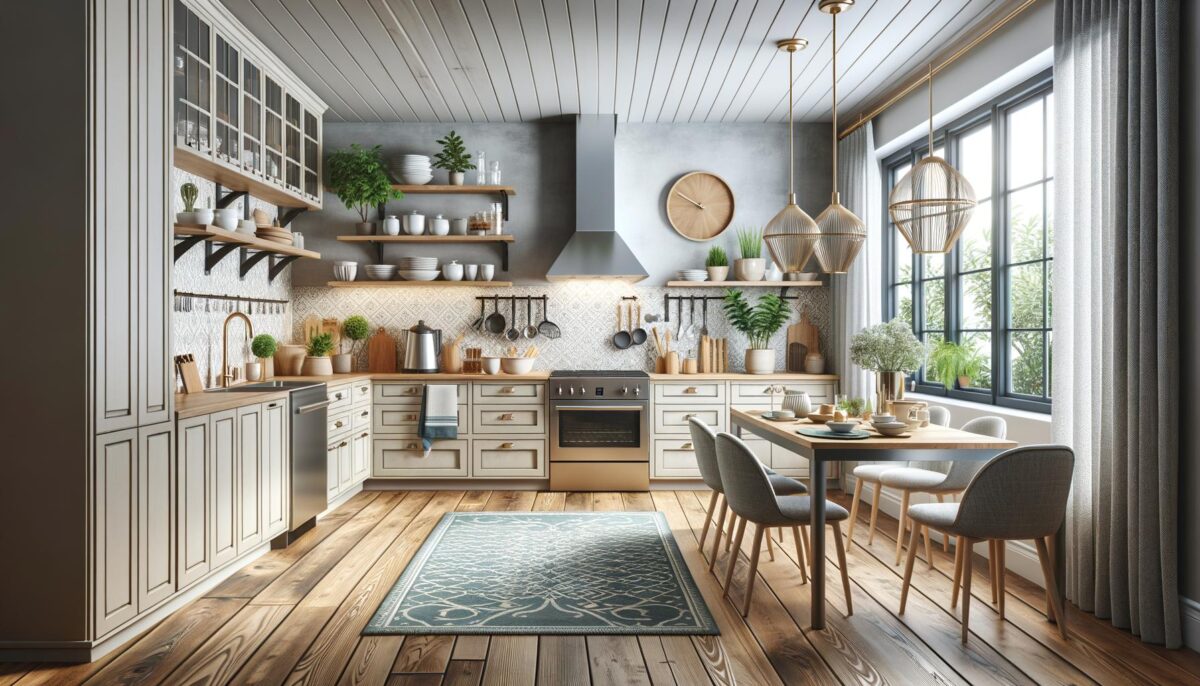Planning Your Layout
When it comes to remodeling your kitchen, the layout is paramount. It’s important to spend time thinking about how you use your kitchen space and what layout will best support your cooking habits. The classic triangular layout, where the stove, refrigerator, and sink are placed in a triangular configuration, remains a popular choice. This setup is designed to enhance efficiency by facilitating easy movement between the key areas.
Consider these points when planning your layout:
- Evaluate your kitchen needs: Do you need more storage or more counter space?
- Consider traffic flow: Ensure there’s enough space to move comfortably around the kitchen.
- Think about functionality: Ensure frequently used items are easy to reach.
Remember that the goal of your layout should be to make cooking not only efficient but also enjoyable. Tailor your layout to your personal preferences and needs.
Choosing the Right Materials
Materials play a significant role in both the functionality and aesthetics of your kitchen. From countertops to flooring, choosing the right materials can greatly impact your kitchen’s durability and style. For countertops, options like granite, quartz, and marble offer durability and an exceptional look. Each material has its own benefits, such as granite’s resistance to stains and scratches, and quartz’s wide range of colors and patterns.
When it comes to flooring, consider materials such as ceramic tiles, hardwood, or vinyl. Ceramic tiles are renowned for being water-resistant and durable, making them a great choice for high-traffic areas. Hardwood flooring offers a classic and warm aesthetic, while vinyl offers a cost-effective solution with a variety of designs.
As you select materials, keep in mind the balance between style, maintenance, and budget. High-quality materials often require an upfront investment but provide longevity and return on your investment over time.
Adequate Lighting Solutions
Lighting is another crucial aspect of kitchen design that can impact both the functionality and atmosphere of the space. Good lighting can make a kitchen not only more inviting but also more functional. Aim for a layered lighting approach that combines ambient, task, and accent lighting. Ambient lighting provides overall illumination; task lighting focuses on specific work areas like countertops and sinks; and accent lighting highlights architectural features or cabinets.
Consider these lighting tips:
- Install under-cabinet lights to illuminate countertops effectively.
- Consider pendant lights over islands or dining areas for added style.
- Use dimmers to adjust lighting levels for different occasions.
The right lighting can also contribute to energy efficiency. Opt for LED lights for energy savings and longer lifespans.
Maximizing Storage and Organization
Efficient storage is vital in any kitchen, especially if space is at a premium. When remodeling, think creatively about how you can maximize the storage capacity of your kitchen. Consider deep drawers instead of traditional cabinets for storing pots and pans, or add pull-out shelves to make it easier to reach items at the back of your pantry.
Other ideas for efficient storage include:
- Adding a lazy Susan to manage corner cabinets.
- Using vertical dividers to organize baking sheets and trays.
- Installing pull-out trash bins to save floor space.
By planning your storage solutions carefully, you can create a kitchen that is clutter-free and easy to navigate, making daily tasks more pleasant.
Considering Eco-Friendly Options
Eco-friendly design is increasingly becoming a key consideration in kitchen remodeling. Not only does it contribute positively to the environment, but it can also enhance the quality of your home life. Consider choosing energy-efficient appliances, which are not only better for the environment but can also save on utility costs over time. Appliances with high energy ratings are a smart, long-term investment.
For eco-friendly options, consider:
- Using sustainable materials like bamboo for flooring or eco-friendly cabinetry.
- Incorporating recycling stations into your kitchen design.
- Installing water-saving faucets and fixtures.
Taking an eco-conscious approach not only benefits the planet but can also add value to your home and create a healthier living space for you and your family.
Conclusion: Your Vision, Your Kitchen
Kitchen remodeling is a significant undertaking that requires thoughtful planning and decision-making. By focusing on layout, materials, lighting, storage, and sustainability, you can transform your culinary space into a haven that meets both practical needs and aesthetic desires. Remember that the ultimate goal of remodeling is to create a kitchen that reflects your personal style and enhances your daily living experiences. With careful consideration and attention to detail, you can achieve a remarkable transformation that brings new energy and functionality to your home.
